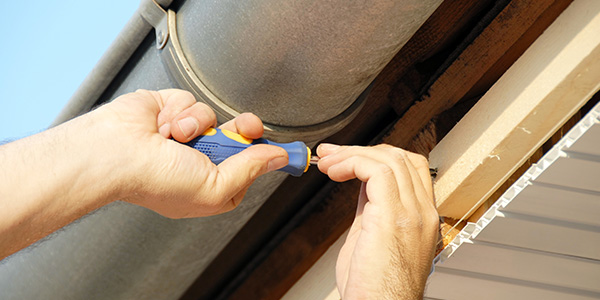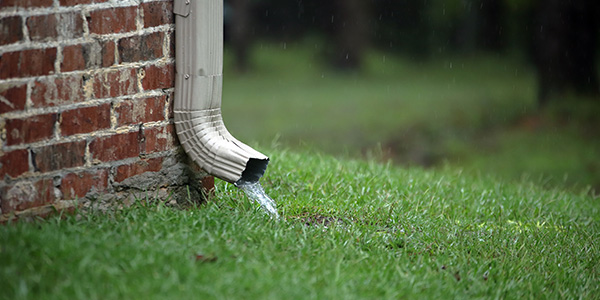How to Make 4 Simple Home Gutter Repairs

4 Simple Home Gutter Repairs
You probably don’t give your gutters much thought, but you have them to thank for every door, window frame and strip of siding that isn’t rotting from water damage. Your gutters are also responsible for protecting your foundation from cracks and your basement from flooding. So, it’s a big deal when they’re not working properly.
Luckily, you don’t have to shell out big bucks to fix gutter problems. With these tips, you’ll learn how to handle the four most common home gutter repairs the DIY way.

How Do Gutters Protect Your Home?
“Most foundations float, so when the soil expands or contracts from uneven moisture levels, the foundation moves up and down. The whole point of the rain gutter system is to keep the moisture level consistent around your house so you avoid that shifting that can cause foundation failures.”
Curt Dyer | Senox Corporation

How to Repair Sagging Gutters
Over time, gutters can sag due to debris pileups, high winds or other unavoidable weather issues. It’s important to fix gutters that are pulling away from the house to avoid drainage problems that could dump water on your foundation. Luckily, repairing sagging gutters is pretty simple.
- Use a claw hammer, pry bar or locking pliers to remove the spikes holding your gutters to the house. If your gutters are held on by screws instead, use a drill to unscrew them.
- If your gutters were secured by spikes, buy gutter screws to replace them. Screws give a sturdier hold.
- If your gutters were secured with screws, replace any that are bent or damaged.
- Line your gutters back up with the existing holes and use a drill to drive in the screws. Be careful not to drill so deeply that you dent the gutter.

Pro Tip
If the screws aren’t quite snug enough, you can dip small strips of wood in all-weather adhesive and push them into the screw holes to better secure them.

When Should You Inspect Your Gutters?
“Wait until after the leaves fall off the trees on your property. Different parts of the country have trees that drop their leaves at different times, so it really depends on the type of vegetation that surrounds your home. If you wait for the right time, most people only need to inspect their gutters once a year.”
Curt Dyer | Senox Corporation

How to Make Gutter Seam Repairs to Fix Leaks
Leaky gutters are a recipe for water damage and foundation issues. This is almost always caused by two sections of gutter pulling apart at the seam during severe weather or temperature fluctuations. Repairing gutter seams takes a bit of time, but it’s a straightforward task most DIYers can handle.
Before you begin, round up these supplies: | |
|---|---|
• Screwdriver | • Medium-grit sandpaper |
Here’s How to Fix Leaky Gutters:
- Use your utility knife to chip away the caulk around the screws connecting the two leaky gutter pieces.
- Remove the screws with your screwdriver and pull the pieces apart.
- Use your utility knife to remove any caulk left on either side of both pieces.
- If there is rust on either gutter piece, use your wire brush to scrap it away. Then smooth the area with sandpaper, apply spray paint and dry completely.
- Use the caulking gun to apply your silicone sealant to the inside lip of the bottom gutter piece, known as the “downhill.”
- Carefully lower the top piece, or “uphill,” into place and press both pieces firmly together for about 30 seconds.
- Replace the screws and apply sealant around them.

Pro Tip
Be thorough removing the old caulk. Your new caulk won’t bond as securely if it’s applied onto leftover residue.

What’s the Worst That Could Happen When You Ignore Your Gutters?
“For foundation failure, cracks in your foundation, you’re going to pay somebody tens of thousands of dollars — or more — to repair your foundation. If your gutters get full, water can get behind the fascia of your house, run down inside the walls and rot them.”
Curt Dyer | Senox Corporation

How to Fix Overflow Problems
If water regularly overflows your gutters and you know they aren’t clogged, then the problem is that they aren’t sloped enough to keep water flowing freely. Your gutters should slope downwards a quarter inch every 10 feet, and when that ratio is off overflows happen. Here’s how to make DIY repairs to this gutter problem.
- At the farthest end from the downspout, measure the distance between the bottom of the fascia board it’s attached to and the bottom of the gutter.
- Move 10 feet down the gutter. Measure and mark the fascia board a quarter inch lower than the original measurement.
- Reposition that section of gutter so that it rests on the mark you made, unscrewing and re-screwing wherever necessary.
- Continue measuring your gutter in 10-foot segments, ensuring that each segment rests a quarter inch lower than the one before it.
- Once you’re done, use a garden hose to double-check that water is now flowing freely.

Pro Tip
If you use gutter hangers, you may be able to bend them to adjust the slope instead of removing and repositioning them.
Ready to tackle more home improvements? Here are 13 that add value!

How to Keep Water From Pooling Around Your House
Water pooling around your foundation should never be ignored. If your gutters aren’t clogged, leaking or improperly sloped, then the problem may be as simple as your downspouts releasing water too close to your home. This incredibly simple gutter repair can save you from costly foundation issues down the road. Just use one of these methods:
- Place a splash block under your downspout. These act as a ramp that directs water further away from your home.
- Attach a roll-up sleeve to the downspout. This is a plastic pouch with perforations at the end that unfurls when filled with rainwater to divert it away from the foundation. When the rain stops, the pouch rolls back up to leave your yard uncluttered.

Pro Tip
You can usually find both of these options for under $20 at your favorite home improvement store.

Want to Save Yourself a Lot of Gutter Maintenance?
“If you have any trees around your home, make sure you have some kind of gutter protection. It can be something as simple as an expanded metal wire mesh, which keeps the big stuff out while the little stuff can still wash through. They’re relatively inexpensive and even a mid-range product will last for decades.”
Curt Dyer | Senox Corporation



